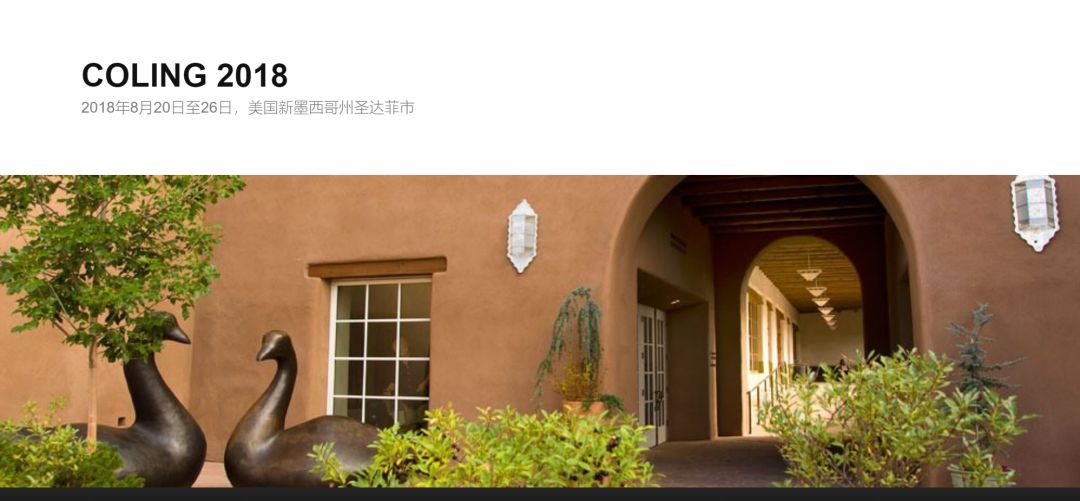COLING 2018-最新论文最全分类-整理分享
第27届计算语言学国际会议(COLING 2018)将于2018年8月20日至26 日在美国新墨西哥州圣达菲市的圣达菲社区会议中心举行。计算语言学国际会议(International Conference on Computational Linguistics,COLING)是计算语言学领域的顶级国际会议,由国际计算语言学学会(International Committee on Computational Linguistics,ICCL)主办,从1965年开始,除少数情况外每两年召开一届。
COLING作为计算语言学、NLP等顶级会议,代表着学术领域最前沿的研究方向,今年的大会必然汇集了很多优秀、前沿的工作,因此对本届大会论文做了简单的分类整理,分享给大家学习借鉴。
分类目录
1. Dialogue and Interactive Systems
2. Question Answering, QA
3. Generation
4. Information Extraction and Text Mining
5. Document Analysis
6. Sentence-level Semantics, Word-level Semantics
7. Sentiment Analysis, Argument Mining
8. Summarization
9. Tagging, Chunking, Syntax and Parsing
10. Vision, Robotics, Multimodal, Grounding and Speech
11. Textual Inference
12. Phonology, Morphology and Word Segmentation
13. Discourse and Pragmatics
14. Social Media
15. Multilinguality
16. Machine Translation
17. Recommendation
Dialogue and Interactive Systems
1. iso-standard domain-independent dialogue act tagging for conversational agents – stefano mezza, alessandra cervone, evgeny stepanov, giuliano tortoreto and giuseppe riccardi.
2. adversarial domain adaptation for variational neural language generation in dialogue systems – van-khanh tran and le-minh nguyen.
3. sequence-to-sequence learning for task-oriented dialogue with dialogue state representation – haoyang wen, yijia liu, wanxiang che, libo qin and ting liu.
4. structured dialogue policy with graph neural networks – lu chen, bowen tan, sishan long and kai yu.
5. a prospective-performance network to alleviate myopia in beam search for response generation – zongsheng wang, yunzhi bai, bowen wu, zhen xu, zhuoran wang and baoxun wang.
6. context-sensitive generation of open-domain conversational responses – wei-nan zhang, yiming cui, yifa wang, qingfu zhu, lingzhi li, lianqiang zhou and ting liu.
7. hl-encdec: a hybrid-level encoder-decoder for neural response generation – sixing wu, dawei zhang, ying li, xing xie and zhonghai wu.
Question Answering, QA
8. dependent gated reading for cloze-style question answering – reza ghaeini, xiaoli fern, hamed shahbazi and prasad tadepalli.
9. extractive headline generation based on learning to rank for community question answering – tatsuru higurashi, hayato kobayashi, takeshi masuyama and kazuma murao.
10. modeling semantics with gated graph neural networks for knowledge base question answering – daniil sorokin and iryna gurevych.
11. neural network models for paraphrase identification, semantic textual similarity, natural language inference, and question answering – wuwei lan and wei xu.
12. pattern-revising enhanced simple question answering over knowledge bases – yanchao hao, hao liu, shizhu he, kang liu and jun zhao.
13. a neural question answering model based on semi-structured tables – hao wang, xiaodong zhang, shuming ma, xu sun, houfeng wang and wang mengxiang.
14. an interpretable reasoning network for multi-relation question answering – mantong zhou, minlie huang and xiaoyan zhu.
15. the apva-turbo approach to question answering in knowledge base – yue wang, richong zhang, cheng xu and yongyi mao.
16. visual question answering dataset for bilingual image understanding: a study of cross-lingual transfer using attention maps – nobuyuki shimizu, na rong and takashi miyazaki.
17. integrating question classification and deep learning for improved answer selection – harish tayyar madabushi, mark lee and john barnden.
18. knowledge as a bridge: improving cross-domain answer selection with external knowledge – yang deng, ying shen, min yang, yaliang li, nan du, wei fan and kai lei.
19. a review on deep learning techniques applied to answer selection – tuan manh lai, trung bui and sheng li.
20. answerable or not: devising a dataset for extending machine reading comprehension – mao nakanishi, tetsunori kobayashi and yoshihiko hayashi.
21. subword-augmented embedding for cloze reading comprehension – zhuosheng zhang, yafang huang and hai zhao.
22. multi-perspective context aggregation for semi-supervised cloze-style reading comprehension – liang wang, sujian li, wei zhao, kewei shen, meng sun, ruoyu jia and jingming liu.
23. reading comprehension with graph-based temporal-casual reasoning – yawei sun, gong cheng and yuzhong qu.
Generation
24. evaluating the text quality, human likeness and tailoring component of pass: a dutch data-to-text system for soccer – chris van der lee, bart verduijn, emiel krahmer and sander wubben.
Information Extraction and Text Mining
25. an empirical study on fine-grained named entity recognition – khai mai, thai-hoang pham, minh trung nguyen, nguyen tuan duc, danushka bollegala, ryohei sasano and satoshi sekine.
26. an exploration of three lightly-supervised representation learning approaches for named entity classification – ajay nagesh and mihai surdeanu.
27. design challenges in named entity transliteration – yuval merhav and stephen ash.
28. a survey on recent advances in named entity recognition from deep learning models – vikas yadav and steven bethard.
29. improving named entity recognition by jointly learning to disambiguate morphological tags – onur gungor, suzan uskudarli and tunga gungor.
30. neural machine translation incorporating named entity – arata ugawa, akihiro tamura, takashi ninomiya, hiroya takamura and manabu okumura.
31. transfer learning for entity recognition of novel classes – juan diego rodriguez, adam caldwell and alexander liu.
32. they exist! introducing plural mentions to coreference resolution and entity linking – ethan zhou and jinho d. choi.
33. adversarial multi-lingual neural relation extraction – xiaozhi wang, xu han, yankai lin, zhiyuan liu and maosong sun.
34. cooperative denoising for distantly supervised relation extraction – kai lei, daoyuan chen, yaliang li, nan du, min yang, wei fan and ying shen.
35. graphene: semantically-linked propositions in open information extraction – matthias cetto, christina niklaus, andré freitas and siegfried handschuh.
36. open information extraction from conjunctive sentences – swarnadeep saha and mausam -.
37. open information extraction on scientific text: an evaluation – paul groth, mike lauruhn, antony scerri and ron daniel, jr..
38. a survey on open information extraction – christina niklaus, matthias cetto, andré freitas and siegfried handschuh.
39. a multi-attention based neural network with external knowledge for story ending predicting task – qian li, ziwei li, jin-mao wei, yanhui gu, adam jatowt and zhenglu yang.
40. modeling semantics with gated graph neural networks for knowledge base question answering – daniil sorokin and iryna gurevych.
41. pattern-revising enhanced simple question answering over knowledge bases – yanchao hao, hao liu, shizhu he, kang liu and jun zhao.
42. attributed and predictive entity embedding for fine-grained entity typing in knowledge bases – hailong jin, lei hou, juanzi li and tiansi dong.
43. cross-lingual knowledge projection using machine translation and target-side knowledge base completion – naoki otani, hirokazu kiyomaru, daisuke kawahara and sadao kurohashi.
44. representation learning of entities and documents from knowledge base descriptions – ikuya yamada, hiroyuki shindo and yoshiyasu takefuji.
45. the apva-turbo approach to question answering in knowledge base – yue wang, richong zhang, cheng xu and yongyi mao.
46. exploratory neural relation classification for domain knowledge acquisition – yan fan, chengyu wang and xiaofeng he.
47. recurrent one-hop predictions for reasoning over knowledge graphs – wenpeng yin, yadollah yaghoobzadeh and hinrich schütze.
48. automatic assessment of conceptual text complexity using knowledge graphs – sanja ?tajner and ioana hulpus.
48. incorporating image matching into knowledge acquisition for event-oriented relation recognition – yu hong, yang xu, huibin ruan, bowei zou, jianmin yao and guodong zhou.
49. retrofitting distributional embeddings to knowledge graphs with functional relations – ben lengerich, andrew maas and christopher potts.
50. neural collective entity linking – yixin cao, lei hou, juanzi li and zhiyuan liu.
51. systematic study of long tail phenomena in entity linking – filip ilievski, piek vossen and stefan schlobach.
52. joint neural entity disambiguation with output space search – hamed shahbazi, xiaoli fern, reza ghaeini, chao ma, rasha mohammad obeidat and prasad tadepalli.
53. deep enhanced representation for implicit discourse relation recognition – hongxiao bai and hai zhao.
54. implicit discourse relation recognition using neural tensor network with interactive attention and sparse learning – fengyu guo, ruifang he, di jin, jianwu dang, longbiao wang and xiangang li.
55. word-level loss extensions for neural temporal relation classification – artuur leeuwenberg and marie-francine moens.
Document Analysis
56. self-normalization properties of language modeling – jacob goldberger and oren melamud.
57. modeling coherence for neural machine translation with dynamic and topic caches – shaohui kuang, deyi xiong, weihua luo and guodong zhou.
58. joint learning from labeled and unlabeled data for information retrieval – bo li, ping cheng and le jia.
Sentence-level Semantics, Word-level Semantics
59. semi-supervised lexicon learning for wide-coverage semantic parsing – bo chen, bo an, le sun and xianpei han.
60. butterfly effects in frame semantic parsing: impact of data processing on model ranking – alexandre kabbach, corentin ribeyre and aurélie herbelot.
61. semantic parsing for technical support questions – abhirut gupta, anupama ray, gargi dasgupta, gautam singh, pooja aggarwal and prateeti mohapatra.
62. a full end-to-end semantic role labeler, syntactic-agnostic over syntactic-aware? – jiaxun cai, shexia he, zuchao li and hai zhao.
63. gold standard annotations for preposition and verb sense with semantic role labels in adult-child interactions – lori moon, christos christodoulopoulos, fisher cynthia, sandra franco and dan roth.
64. who feels what and why? annotation of a literature corpus with semantic roles of emotions – evgeny kim and roman klinger.
65. convolutional neural network for universal sentence embeddings – xiaoqi jiao, fang wang and dan feng.
66. learning semantic sentence embeddings using sequential pair-wise discriminator – badri narayana patro, vinod kumar kurmi, sandeep kumar and vinay namboodiri.
67. a deep dive into word sense disambiguation with lstm – minh le, marten postma, jacopo urbani and piek vossen.
68. using word embeddings for unsupervised acronym disambiguation – jean charbonnier and christian wartena.
69. word sense disambiguation based on word similarity calculation using word vector representation from a knowledge-based graph – dongsuk o, sunjae kwon, kyungsun kim and youngjoong ko.
70. relation induction in word embeddings revisited – zied bouraoui, shoaib jameel and steven schockaert.
71. from text to lexicon: bridging the gap between word embeddings and lexical resources – ilia kuznetsov and iryna gurevych.
72. diachronic word embeddings and semantic shifts: a survey – andrey kutuzov, lilja ?vrelid, terrence szymanski and erik velldal.
73. enriching word embeddings with domain knowledge for readability assessment – zhiwei jiang, qing gu, yafeng yin and daoxu chen.
74. seven: augmenting word embeddings with unsupervised relation vectors – luis espinosa anke and steven schockaert.
75. summarization evaluation in the absence of human model summaries using the compositionality of word embeddings – elaheh shafieibavani, mohammad ebrahimi, raymond wong and fang chen.
76. toward better loanword identification in uyghur using cross-lingual word embeddings – chenggang mi, yating yang, lei wang, xi zhou and tonghai jiang.
77. a lstm approach with sub-word embeddings for mongolian phrase break prediction – rui liu, feilong bao, guanglai gao, hui zhang and yonghe wang.
78. treat us like the sequences we are: prepositional paraphrasing of noun compounds using lstm – girishkumar ponkiya, kevin patel, pushpak bhattacharyya and girish palshikar.
79. par4sim — adaptive paraphrasing for text simplification – seid muhie yimam and chris biemann.
80. exploratory neural relation classification for domain knowledge acquisition – yan fan, chengyu wang and xiaofeng he.
81. incorporating image matching into knowledge acquisition for event-oriented relation recognition – yu hong, yang xu, huibin ruan, bowei zou, jianmin yao and guodong zhou.
82. if you’ve seen some, you’ve seen them all: identifying variants of multiword expressions – caroline pasquer, agata savary, carlos ramisch and jean-yves antoine.
Sentiment Analysis, Argument Mining
83. a lexicon-based supervised attention model for neural sentiment analysis – yicheng zou, tao gui, qi zhang and xuanjing huang.
84. a position-aware bidirectional attention network for aspect-level sentiment analysis – shuqin gu, lipeng zhang, yuexian hou and yin song.
85. bringing replication and reproduction together with generalisability in nlp: three reproduction studies for target dependent sentiment analysis – andrew moore and paul rayson.
86. expressively vulgar: the socio-dynamics of vulgarity and its effects on sentiment analysis in social media – isabel cachola, eric holgate, daniel preo?iuc-pietro and junyi jessy li.
87. representations and architectures in neural sentiment analysis for morphologically rich languages: a case study from modern hebrew – adam amram, anat ben-david and reut tsarfaty.
88. simple algorithms for sentiment analysis on sentiment rich, data poor domains. – prathusha k sarma and william sethares.
89. encoding sentiment information into word vectors for sentiment analysis – zhe ye, fang li and timothy baldwin.
90. projecting embeddings for domain adaption: joint modeling of sentiment analysis in diverse domains – jeremy barnes, roman klinger and sabine schulte im walde.
91. rusentiment: an enriched sentiment analysis dataset for social media in russian – anna rogers, alexey romanov, anna rumshisky, svitlana volkova, mikhail gronas and alex gribov.
92. twitter corpus of resource-scarce languages for sentiment analysis and multilingual emoji prediction – nurendra choudhary, rajat singh, vijjini anvesh rao and manish shrivastava.
Summarization
91. abstractive unsupervised multi-document summarization using paraphrastic sentence fusion – mir tafseer nayeem, tanvir ahmed fuad and yllias chali.
92. aspect and sentiment aware abstractive review summarization – min yang, qiang qu, ying shen, qiao liu, wei zhao and jia zhu.
93. structure-infused copy mechanisms for abstractive summarization – kaiqiang song, lin zhao and fei liu.
94. ensure the correctness of the summary: incorporate entailment knowledge into abstractive sentence summarization – haoran li, junnan zhu, jiajun zhang and chengqing zong.
95. summarization evaluation in the absence of human model summaries using the compositionality of word embeddings – elaheh shafieibavani, mohammad ebrahimi, raymond wong and fang chen.
96. abstract meaning representation for multi-document summarization – kexin liao, logan lebanoff and fei liu.
97. ant colony system for multi-document summarization – asma al-saleh and mohamed el bachir menai.
98. dynamic multi-level multi-task learning for sentence simplification – han guo, ramakanth pasunuru and mohit bansal.
Tagging, Chunking, Syntax and Parsing
99. part-of-speech tagging on an endangered language: a parallel griko-italian resource – antonios anastasopoulos, marika lekakou, josep quer, eleni zimianiti, justin debenedetto and david chiang.
100. rich character-level information for korean morphological analysis and part-of-speech tagging – andrew matteson, chanhee lee, youngbum kim and heuiseok lim.
101. seq2seq dependency parsing – zuchao li, jiaxun cai, shexia he and hai zhao.
semi-supervised lexicon learning for wide-coverage semantic parsing – bo chen, bo an, le sun and xianpei han.
102. butterfly effects in frame semantic parsing: impact of data processing on model ranking – alexandre kabbach, corentin ribeyre and aurélie herbelot.
103. semantic parsing for technical support questions – abhirut gupta, anupama ray, gargi dasgupta, gautam singh, pooja aggarwal and prateeti mohapatra.
Vision, Robotics, Multimodal, Grounding and Speech
104. self-normalization properties of language modeling – jacob goldberger and oren melamud.
105. multimodal grounding for language processing – lisa beinborn, teresa botschen and iryna gurevych.
Textual Inference
106. grounded textual entailment – hoa vu, claudio greco, aliia erofeeva, somayeh jafaritazehjan, guido linders, marc tanti, alberto testoni, raffaella bernardi and albert gatt.
107. embedding wordnet knowledge for textual entailment – yunshi lan and jing jiang.
anlamver: semantic model evaluation dataset for turkish – word similarity and relatedness – g?khan ercan and olcay taner y?ld?z.
108. neural network models for paraphrase identification, semantic textual similarity, natural language inference, and question answering – wuwei lan and wei xu.
109. semi-supervised lexicon learning for wide-coverage semantic parsing – bo chen, bo an, le sun and xianpei han.
110. butterfly effects in frame semantic parsing: impact of data processing on model ranking – alexandre kabbach, corentin ribeyre and aurélie herbelot.
111. semantic parsing for technical support questions – abhirut gupta, anupama ray, gargi dasgupta, gautam singh, pooja aggarwal and prateeti mohapatra.
Phonology, Morphology and Word Segmentation
112. representations and architectures in neural sentiment analysis for morphologically rich languages: a case study from modern hebrew – adam amram, anat ben-david and reut tsarfaty.
113. rich character-level information for korean morphological analysis and part-of-speech tagging – andrew matteson, chanhee lee, youngbum kim and heuiseok lim.
114. adaptive multi-task transfer learning for chinese word segmentation in medical text – junjie xing, kenny zhu and shaodian zhang.
115. urdu word segmentation using conditional random fields (crfs) – haris bin zia, agha ali raza and awais athar.
Discourse and Pragmatics
116. they exist! introducing plural mentions to coreference resolution and entity linking – ethan zhou and jinho d. choi.
118. triad-based neural network for coreference resolution – yuanliang meng and anna rumshisky.
119. graph based decoding for event sequencing and coreference resolution – zhengzhong liu, teruko mitamura and eduard hovy.
Social Media
120. low-resource cross-lingual event type detection via distant supervision with minimal effort – aldrian obaja muis, naoki otani, nidhi vyas, ruochen xu, yiming yang, teruko mitamura and eduard hovy.
121. open-domain event detection using distant supervision – jun araki and teruko mitamura.
122. a retrospective analysis of the fake news challenge stance-detection task – andreas hanselowski, avinesh pvs, benjamin schiller, felix caspelherr, debanjan chaudhuri, christian m. meyer and iryna gurevych.
123. attending sentences to detect satirical fake news – sohan de sarkar, fan yang and arjun mukherjee.
124. automatic detection of fake news – verónica pérez-rosas, bennett kleinberg, alexandra lefevre and rada mihalcea.
125. multi-source multi-class fake news detection – hamid karimi, proteek roy, sari saba-sadiya and jiliang tang.
126. cascade: contextual sarcasm detection in online discussion forums – devamanyu hazarika, soujanya poria, sruthi gorantla, erik cambria, roger zimmermann and rada mihalcea.
Multilinguality
127. learning multilingual topics from incomparable corpora – shudong hao and michael j. paul.
Machine Translation
128. a comparison of transformer and recurrent neural networks on multilingual neural machine translation – surafel melaku lakew, mauro cettolo and marcello federico.
129. cross-lingual argumentation mining: machine translation (and a bit of projection) is all you need! – steffen eger, johannes daxenberger, christian stab and iryna gurevych.
130. extracting parallel sentences with bidirectional recurrent neural networks to improve machine translation – francis grégoire and philippe langlais.
131. fusing recency into neural machine translation with an inter-sentence gate model – shaohui kuang and deyi xiong.
132. improving neural machine translation by incorporating hierarchical subword features – makoto morishita, jun suzuki and masaaki nagata.
133. modeling coherence for neural machine translation with dynamic and topic caches – shaohui kuang, deyi xiong, weihua luo and guodong zhou.
134. multilingual neural machine translation with task-specific attention – graeme blackwood, miguel ballesteros and todd ward.
neural machine translation with decoding history enhanced attention – mingxuan wang.
135. on adversarial examples for character-level neural machine translation – javid ebrahimi, daniel lowd and dejing dou.
136. a survey of domain adaptation for neural machine translation – chenhui chu and rui wang.
137. adaptive weighting for neural machine translation – yachao li, junhui li and min zhang.
138. an evaluation of neural machine translation models on historical spelling normalization – gongbo tang, fabienne cap, eva pettersson and joakim nivre.
139. cross-lingual knowledge projection using machine translation and target-side knowledge base completion – naoki otani, hirokazu kiyomaru, daisuke kawahara and sadao kurohashi.
140. deconvolution-based global decoding for neural machine translation – junyang lin, xu sun, xuancheng ren, shuming ma, jinsong su and qi su.
141. incorporating syntactic uncertainty in neural machine translation with a forest-to-sequence model – poorya zaremoodi and gholamreza haffari.
142. multi-layer representation fusion for neural machine translation – qiang wang, fuxue li, tong xiao, yanyang li, yinqiao li and jingbo zhu.
143. neural machine translation incorporating named entity – arata ugawa, akihiro tamura, takashi ninomiya, hiroya takamura and manabu okumura.
144. parallel corpora for bi-lingual english-ethiopian languages statistical machine translation – michael melese, solomon teferra abate, martha yifiru tachbelie, million meshesha, wondwossen mulugeta, yaregal assibie, solomon atinafu, binyam ephrem, tewodros abebe, hafte abera, amanuel lemma, tsegaye andargie, seifedin shifaw and wondimagegnhue tsegaye.
145. refining source representations with relation networks for neural machine translation – wen zhang, hu jiawei, yang feng and qun liu.
146. sentence weighting for neural machine translation domain adaptation – shiqi zhang and deyi xiong.
147. combining information-weighted sequence alignment and sound correspondence models for improved cognate detection – johannes dellert.
148. design challenges in named entity transliteration – yuval merhav and stephen ash.
149. adversarial domain adaptation for variational neural language generation in dialogue systems – van-khanh tran and le-minh nguyen.
recommendation
150. authorship identification for literary book recommendations – haifa alharthi, diana inkpen and stan szpakowicz.
DeepLearning_NLP

深度学习与NLP

商务合作请联系微信号:lqfarmerlq









